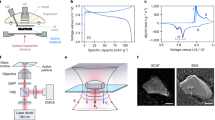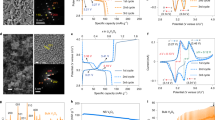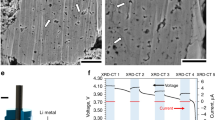Abstract
To rationalize and improve the performance of newly developed high-rate battery electrode materials, it is crucial to understand the ion intercalation and degradation mechanisms occurring during realistic battery operation. Here we apply a laboratory-based operando optical scattering microscopy method to study micrometre-sized rod-like particles of the anode material Nb14W3O44 during high-rate cycling. We directly visualize elongation of the particles, which, by comparison with ensemble X-ray diffraction, allows us to determine changes in the state of charge of individual particles. A continuous change in scattering intensity with state of charge enables the observation of non-equilibrium kinetic phase separations within individual particles. Phase field modelling (informed by pulsed-field-gradient nuclear magnetic resonance and electrochemical experiments) supports the kinetic origin of this separation, which arises from the state-of-charge dependence of the Li-ion diffusion coefficient. The non-equilibrium phase separations lead to particle cracking at high rates of delithiation, particularly in longer particles, with some of the resulting fragments becoming electrically disconnected on subsequent cycling. These results demonstrate the power of optical scattering microscopy to track rapid non-equilibrium processes that would be inaccessible with established characterization techniques.
This is a preview of subscription content, access via your institution
Access options
Access Nature and 54 other Nature Portfolio journals
Get Nature+, our best-value online-access subscription
$29.99 / 30 days
cancel any time
Subscribe to this journal
Receive 12 print issues and online access
$259.00 per year
only $21.58 per issue
Buy this article
- Purchase on Springer Link
- Instant access to full article PDF
Prices may be subject to local taxes which are calculated during checkout





Similar content being viewed by others
Data availability
The data underlying the figures in the main text are publicly available from the University of Cambridge repository at https://doi.org/10.17863/CAM.85438.
Code availability
The code used to perform phase field modelling is publicly available from the University of Cambridge repository at https://doi.org/10.17863/CAM.85438.
References
Zhang, Y., Yang, Z. & Tian, C. Probing and quantifying cathode charge heterogeneity in Li ion batteries. J. Mater. Chem. A 7, 23628–23661 (2019).
Davis, A. L. et al. Rate limitations in composite solid-state battery electrodes: revealing heterogeneity with operando microscopy. ACS Energy Lett. 6, 2993–3003 (2021).
Chen, Y. et al. Operando video microscopy of Li plating and re-intercalation on graphite anodes during fast charging. J. Mater. Chem. A 9, 23522–23536 (2021).
Xu, Y. et al. In situ visualization of state-of-charge heterogeneity within a LiCoO2 particle that evolves upon cycling at different rates. ACS Energy Lett. 2, 1240–1245 (2017).
Xu, J., Deshpande, R. D., Pan, J., Cheng, Y.-T. & Battaglia, V. S. Electrode side reactions, capacity loss and mechanical degradation in lithium-ion batteries. J. Electrochem. Soc. 162, A2026 (2015).
Rinkel, B. L. D., Hall, D. S., Temprano, I. & Grey, C. P. Electrolyte oxidation pathways in lithium-ion batteries. J. Am. Chem. Soc. 142, 15058–15074 (2020).
Schweidler, S. et al. Investigation into mechanical degradation and fatigue of high-Ni NCM cathode material: a long-term cycling study of full cells. ACS Appl. Energy Mater. 2, 7375–7384 (2019).
Yan, P. et al. Intragranular cracking as a critical barrier for high-voltage usage of layer-structured cathode for lithium-ion batteries. Nat. Commun. 8, 14101 (2017).
Liu, H. et al. Intergranular cracking as a major cause of long-term capacity fading of layered cathodes. Nano Lett. 17, 3452–3457 (2017).
He, K. et al. Operando liquid cell electron microscopy of discharge and charge kinetics in lithium-oxygen batteries. Nano Energy 49, 338–345 (2018).
Holtz, M. E. et al. Nanoscale imaging of lithium ion distribution during in situ operation of battery electrode and electrolyte. Nano Lett. 14, 1453–1459 (2014).
Lim, J. et al. Origin and hysteresis of lithium compositional spatiodynamics within battery primary particles. Science 353, 566–571 (2016).
Li, S. et al. Mutual modulation between surface chemistry and bulk microstructure within secondary particles of nickel-rich layered oxides. Nat. Commun. 11, 4433 (2020).
Yu, Y.-S. et al. Three-dimensional localization of nanoscale battery reactions using soft X-ray tomography. Nat. Commun. 9, 921 (2018).
Zhang, X. et al. Direct view on the phase evolution in individual LiFePO4 nanoparticles during Li-ion battery cycling. Nat. Commun. 6, 8333 (2015).
Park, J. et al. Fictitious phase separation in Li layered oxides driven by electro-autocatalysis. Nat. Mater. 20, 991–999 (2021).
Liu, H. et al. Capturing metastable structures during high-rate cycling of LiFePO4 nanoparticle electrodes. Science 344, 1252817 (2014).
Griffith, K. J., Wiaderek, K. M., Cibin, G., Marbella, L. E. & Grey, C. P. Niobium tungsten oxides for high-rate lithium-ion energy storage. Nature 559, 556–563 (2018).
Hyun, H. et al. Suppressing high-current-induced phase separation in Ni-rich layered oxides by electrochemically manipulating dynamic lithium distribution. Adv. Mater. 33, e2105337 (2021).
Grenier, A. et al. Intrinsic kinetic limitations in substituted lithium-layered transition-metal oxide electrodes. J. Am. Chem. Soc. 142, 7001–7011 (2020).
Xu, C. et al. Bulk fatigue induced by surface reconstruction in layered Ni-rich cathodes for Li-ion batteries. Nat. Mater. 20, 84–92 (2021).
Merryweather, A. J., Schnedermann, C., Jacquet, Q., Grey, C. P. & Rao, A. Operando optical tracking of single-particle ion dynamics in batteries. Nature 594, 522–528 (2021).
Ortega Arroyo, J., Cole, D. & Kukura, P. Interferometric scattering microscopy and its combination with single-molecule fluorescence imaging. Nat. Protoc. 11, 617–633 (2016).
Priest, L., Peters, J. S. & Kukura, P. Scattering-based light microscopy: from metal nanoparticles to single proteins. Chem. Rev. 121, 11937–11970 (2021).
Saqib, M., Fan, Y., Hao, R. & Zhang, B. Optical imaging of nanoscale electrochemical interfaces in energy applications. Nano Energy 90, 106539 (2021).
Koçer, C. P., Griffith, K. J., Grey, C. P. & Morris, A. J. Cation disorder and lithium insertion mechanism of Wadsley–Roth crystallographic shear phases from first principles. J. Am. Chem. Soc. 141, 15121–15134 (2019).
Yang, Y. et al. Achieving ultrahigh-rate and high-safety Li+ storage based on interconnected tunnel structure in micro-size niobium tungsten oxides. Adv. Mater. 32, 1905295 (2020).
Lv, Z. et al. Cation mixing in Wadsley-Roth phase anode of lithium-ion battery improves cycling stability and fast Li+ storage. Appl. Phys. Rev. 8, 031404 (2021).
Koçer, C. P., Griffith, K. J., Grey, C. P. & Morris, A. J. Lithium diffusion in niobium tungsten oxide shear structures. Chem. Mater. 32, 3980–3989 (2020).
Roth, R. S. & Waring, J. L. Phase equilibria as related to crystal structure in the system niobium pentoxide-tungsten trioxide. J. Res. Natl Bur. Stand. A Phys. Chem. 70A, 281–303 (1966).
Cava, R. J., Murphy, D. W. & Zahurak, S. M. Lithium insertion in Wadsley‐Roth phases based on niobium oxide. J. Electrochem. Soc. 130, 2345–2351 (1983).
Stallmach, F., Kärger, J., Krause, C., Jeschke, M. & Oberhagemann, U. Evidence of anisotropic self-diffusion of guest molecules in nanoporous materials of MCM-41 type. J. Am. Chem. Soc. 122, 9237–9242 (2000).
Evans, R. C., Nilsson, Z. N. & Sambur, J. B. High-throughput single-nanoparticle-level imaging of electrochemical ion insertion reactions. Anal. Chem. 91, 14983–14991 (2019).
Morcrette, M. et al. In situ X-ray diffraction techniques as a powerful tool to study battery electrode materials. Electrochim. Acta 47, 3137–3149 (2002).
de Souza, B., Farias, G., Neese, F. & Izsák, R. Predicting phosphorescence rates of light organic molecules using time-dependent density functional theory and the path integral approach to dynamics. J. Chem. Theory Comput. 15, 1896–1904 (2019).
Zaremba, S. K. Good lattice points, discrepancy, and numerical integration. Ann. Mat. Pura Appl. 73, 293–317 (1966).
Conroy, H. Molecular Schrödinger equation. VIII. A new method for the evaluation of multidimensional integrals. J. Chem. Phys. 47, 5307–5318 (1967).
Cheng, V. B., Suzukawa, H. H. & Wolfsberg, M. Investigations of a nonrandom numerical method for multidimensional integration. J. Chem. Phys. 59, 3992–3999 (1973).
Deng, Y. & Chu, D. Coherence properties of different light sources and their effect on the image sharpness and speckle of holographic displays. Sci. Rep. 7, 5893 (2017).
Schindelin, J. et al. Fiji: an open-source platform for biological-image analysis. Nat. Methods 9, 676–682 (2012).
Acknowledgements
This work was supported by the Faraday Institution, FIRG012 and FIRG024. A.J.M. acknowledges support from the Engineering and Physical Sciences Research Council (EPSRC) Cambridge NanoDTC, EP/L015978/1. C.S. acknowledges financial support by the Royal Commission of the Exhibition of 1851. We acknowledge financial support from the EPSRC and the Winton Program for the Physics of Sustainability. This project has received funding from the European Research Council under the European Union’s Horizon 2020 research and innovation programme (grant agreement no. 758826). C.P.G., S.P.E. and A.J.M. were supported by a European Research Council Advanced Investigator Grant for C.P.G. (EC H2020 835073). Use of the Advanced Photon Source at Argonne National Laboratory was supported by the US Department of Energy, Office of Science, Office of Basic Energy Sciences, under contract no. DE-AC02-06CH11357. We thank S. Nagendran and J. Thuillier for their help with synthesizing the materials and with the PFG-NMR measurements, P. Magusin for advice regarding the PFG-NMR measurements, B. Mockus for help with the code development and F. Alford for useful discussions regarding analysis of optical data.
Author information
Authors and Affiliations
Contributions
C.P.G. and A.R. conceived the idea and supervised the project. A.J.M., Q.J. and C.S. planned all experiments. Q.J. and A.J.M. prepared samples. A.J.M. and C.S. constructed the optical set-up and carried out the optical measurements. Q.J. performed the XRD and GITT measurements and the modelling. Q.J. and S.P.E. carried out the PFG-NMR experiments. All authors discussed the results and contributed to writing the manuscript.
Corresponding authors
Ethics declarations
Competing interests
C.P.G. is a major shareholder and cofounder of Nyobolt, a start-up company developing fast-charging batteries based on high-rate anode materials. The remaining authors declare no competing interests.
Peer review
Peer review information
Nature Materials thanks Sanli Faez, Justin Sambur and Venkatasubramanian Viswanathan for their contribution to the peer review of this work.
Additional information
Publisher’s note Springer Nature remains neutral with regard to jurisdictional claims in published maps and institutional affiliations.
Supplementary information
Supplementary Information
Supplementary Figs. 1–21, Tables 1–5 and Discussions.
Supplementary Video 1
Optical response of active NWO particles during one galvanostatic cycle at 5C.
Supplementary Video 2
Differential images of the active NWO particles at the start of 5C lithiation, with and without a preceding 2.8 V hold.
Supplementary Video 3
Intensity and differential images of an active NWO particle during 5C delithiation from high Li content, including particle cracking.
Supplementary Video 4
Intensity and differential images of an active NWO particle during 20C delithiation from high Li content.
Rights and permissions
Springer Nature or its licensor holds exclusive rights to this article under a publishing agreement with the author(s) or other rightsholder(s); author self-archiving of the accepted manuscript version of this article is solely governed by the terms of such publishing agreement and applicable law.
About this article
Cite this article
Merryweather, A.J., Jacquet, Q., Emge, S.P. et al. Operando monitoring of single-particle kinetic state-of-charge heterogeneities and cracking in high-rate Li-ion anodes. Nat. Mater. 21, 1306–1313 (2022). https://doi.org/10.1038/s41563-022-01324-z
Received:
Accepted:
Published:
Issue Date:
DOI: https://doi.org/10.1038/s41563-022-01324-z
This article is cited by
-
In situ monitoring redox processes in energy storage using UV–Vis spectroscopy
Nature Energy (2023)
-
Three-dimensional operando optical imaging of particle and electrolyte heterogeneities inside Li-ion batteries
Nature Nanotechnology (2023)
-
Asynchronous domain dynamics and equilibration in layered oxide battery cathode
Nature Communications (2023)



